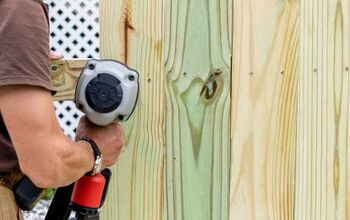Do You Need A Permit To Dig A Trench? (Find Out Now!)

A trench is used to hide drainage systems and to bury utility lines. These can be dug by the homeowner or by a professional company, depending on the depth and size of the trench. Trenches are most often dug in order to hide many utility lines around your property. So before doing any digging, consult with your utility companies so they can come and mark their lines.
In most states, you will not need a permit in order to dig a trench. There are some situations in which you would, depending on the depth of the trench. Generally speaking, you do not need permission to dig a hole in the ground.
What you do need to do is contact your utility companies before beginning any digging. They will come out and mark the area where their buried lines are. You do not want to be digging into utility lines as this will be costly and could be very dangerous.
If you need to dig a trench to lay electrical wires, new pipes, or install drainage because of a spring, you can tackle this yourself. Trenches come in many sizes, from the tiny rows you create in your garden for seeds, to massive holes for setting foundation.
Unless you are building new construction, the trench that you need will probably be able to be done by hand. You can often get away with using hand tools and not need to rent large, expensive equipment too!
Do You Need Landscaping Services?
Get free, zero-commitment quotes from pro contractors near you.

Trench Tools
Most trenches that a homeowner will dig will be relatively short and not too deep. You can often do this using a shovel, either manual or a trench shovel, without the need for powered machinery. Even if you are digging a longer trench that requires the use of a trencher, you will always need a shovel handy.
There are a few types of hand tools that are used for digging trenches.
- The Sharpshooter Shovel (also known as the drainage spade)
- Trenching Shovels
- Trenching Hoe
The Sharpshooter Shovel
The Sharpshooter Shovel is the tool you will use for digging shallow trenches that are up to 12” deep. This shovel has a narrow point which makes it ideal for penetrating sod, hard soil, and dirt that has a lot of rocks in it. Because of its long blade, it’s a great choice for digging trenches in order to lay utilities lines and drainage.
These have multiple handle lengths, with most homeowners going with the shorter version. This shovel will help to create a trench that has a rough rounded bottom. This is what you would use for laying flexible utility lines, such as low voltage wiring and sprinkler pipes. Its also a good choice for shallow drainage pipes that are used to move water away from your house, like for a French drain.
Trenching Shovels
There are two types of trenching shovels:
- Trench Digging Shovels
- Clean Out Shovels
Trenching Shovels are used for digging narrow trenches with flat bottoms. Because of the turned back surface, you can step on the shovel, pushing it into the ground. This makes digging into hard soil much easier. The handles have high lift angles, which will help you lift the soil out of the trench and move it somewhere else. While this is awkward to use at first, you will quickly grow used to it and see the benefits.
Clean-Out shovels are what you will use to remove the loose soil that is left at the bottom of the trench. These crumbs will be left behind if you are cutting your trench with a power trencher. Using a Clean-Out shovel will give you a nice level surface for drainage and other pipes to lie on top of.
Most Clean-Out shovels have a high handle height so that you don’t break your back bending over to remove the soil. The sidewalls of the shovel are made high as well, so that you can scoop a lot of soil at once without it spilling over the sides. This also helps to keep the walls of the trench smooth.
Trenching Hoe
A trenching hoe is used for digging flat bottomed trenches. A power or chain trencher will cut an angled ramp in the soil, which it uses to drag the loose soil up and out of the hole. This is the same process, except by hand. You will create a ramp for pulling out the soil. Then starting at the top of the ramp, you will chop with the trenching hoe, then pull the soil out.
How to Dig a Trench
Before You Begin
When you need to dig a trench, deciding on whether or not use you will use hand tools or power tools will depend on a few things:
- How deep is your trench going to be?
- How long is your trench going to be?
- What are you digging into?
- How fit are you?
The deepest working tools for manual trench digging are meant for up to a 24” trench. Anything deeper than that is going to be a hassle to work with, because of the angle. Sometimes you need to dig a trench deeper than that, for say, water pipes that you don’t want to freeze. In this case, you can dig two trenches, one top of the other.
Using Hand Tools
To do this you would start by digging a trench that is wider than you need it to be. This allows you the space to stand and work in the trench. Using your spade or shovel, dig a trench that is 18” deep and about 26” wide. This will take into account the space needed for you and your tools, to do their work.
The second trench you dig will only be 6” deep, far enough into the ground to get past the frost line. When you are digging out your trench, keep the soil that you remove close by. This will make it easier when it comes time to pull it back in to cover up your pipes.
Using Power Tools
If you decide to use a power trencher to dig, you can go with a walk-behind trencher. These are good for creating narrow and medium depth trenches. With a power trencher, the digging chain is at the rear and you walk backward to dig the trench. These carry a lot more risk than using hand tools, so make sure that you are following all safety precautions.
Depending on what your trench is used for will require different materials, though all trenches are essentially created the same way. You are simply digging an elongated hole in the ground in order to hide something or redirect something. As long as you make sure to get the proper tools and set aside enough time, you can handle this project on your own without needing to outsource any help.
Do You Need Landscaping Services?
Get free, zero-commitment quotes from pro contractors near you.

Related Questions
How Long Would it take to Dig a Trench?
How long it will take you to dig a trench depends on the variables. Typically, it will take about 12 hours to dig 100 linear feet of a trench. You need to take into account if you are digging the trench using hand tools or power tools. How long will the trench will be? How tough is the ground you are digging up? Do you have to work around any utility lines?Knowing the answers to these questions before you start will help you make a better estimation of your time.
Is there a machine to dig trenches?
If you want to dig a trench using a machine, what you will be looking for is a trencher. This is a piece of construction equipment that is used for laying pipes and electrical cables and installing drainage. For residential use, you will probably want to go with a walk-behind model. These can be about the size of a lawnmower and should be more than adequate to do the job.For larger projects, there are trenchers that are attached to a tractor or skid loader. These can be quite massive and used for large-scale building operations.
Should I Wet the Ground Before Digging?
It is not recommended to dig while the soil is wet. It will be much heavier to work with and cause unnecessary strain. It is also difficult to break apart later, as wet soil forms clods.To test if a soil is too wet: Take a handful of soil and form it into a ball the size of a baseball. Strike the ball with the heel of one hand and if you see an imprint of your hand in the soil, it is too wet to work with. If it crumbles when you hit it, then it’s a good consistency to start digging.
Related Guides

Sean Jarvis is an interior decorator, writer, and expert handyman. Well versed in everything home improvement, he is a savant at manipulating words and spaces and upgrading everything around him. Sean specializes in writing concise guides about appliance repair and installation, home and lifestyle, and other residential projects.
More by Sean Jarvis

























![How To Reset A Whirlpool Cabrio Washer [In 5 Easy Steps!]](https://cdn-fastly.upgradedhome.com/media/2023/07/31/9076531/how-to-reset-a-whirlpool-cabrio-washer-in-5-easy-steps.jpg?size=350x220)

